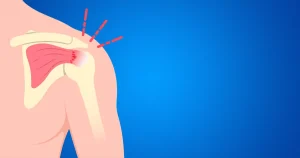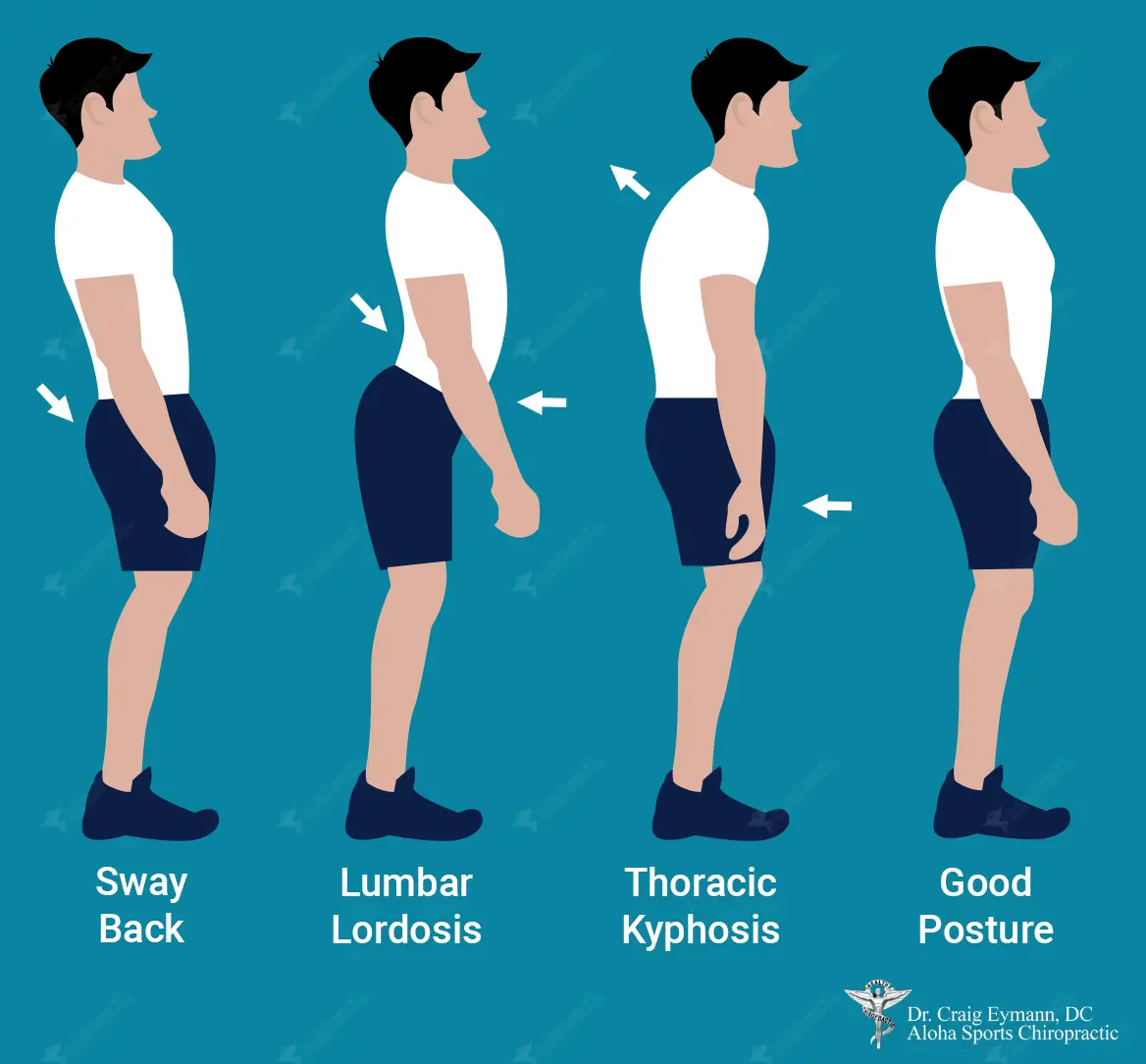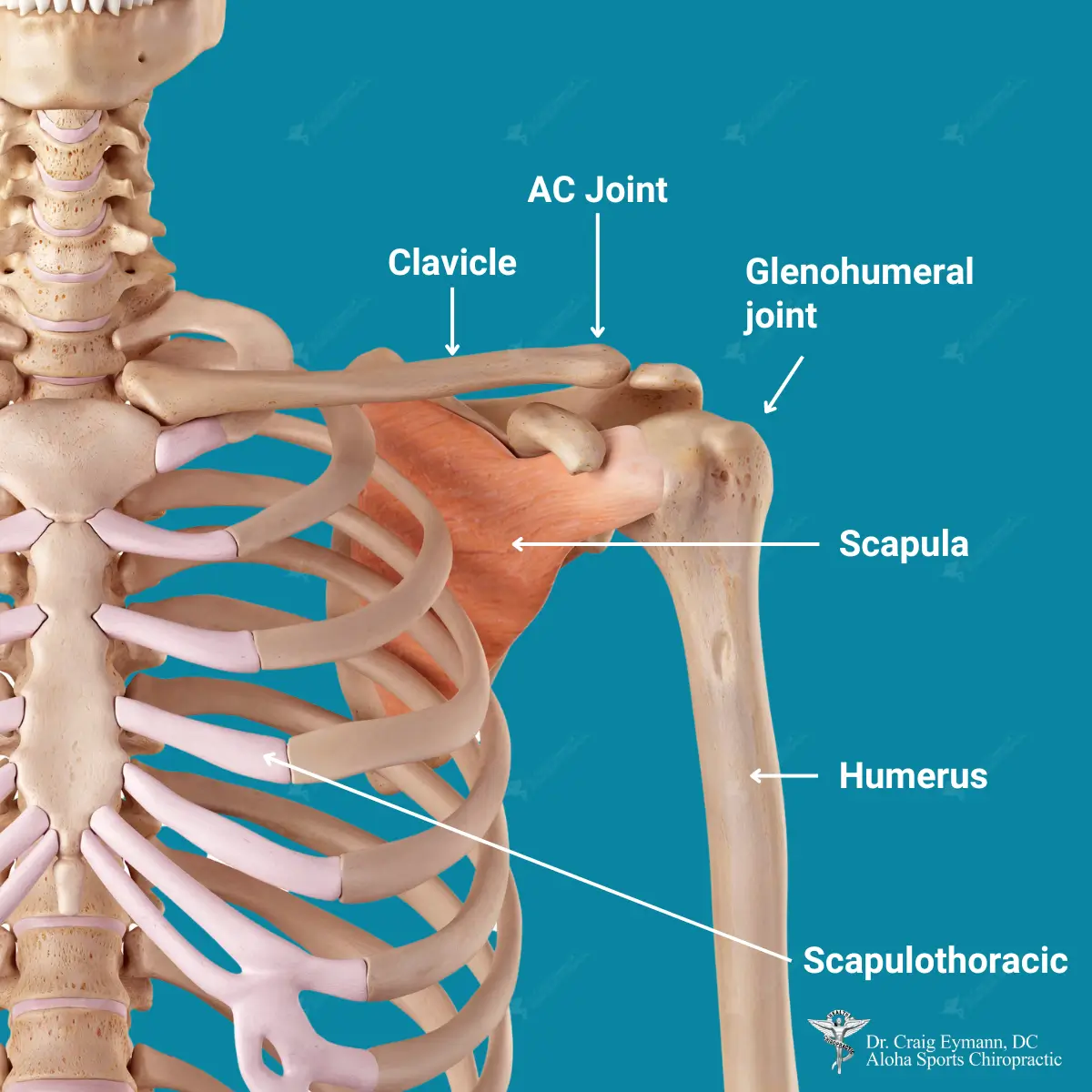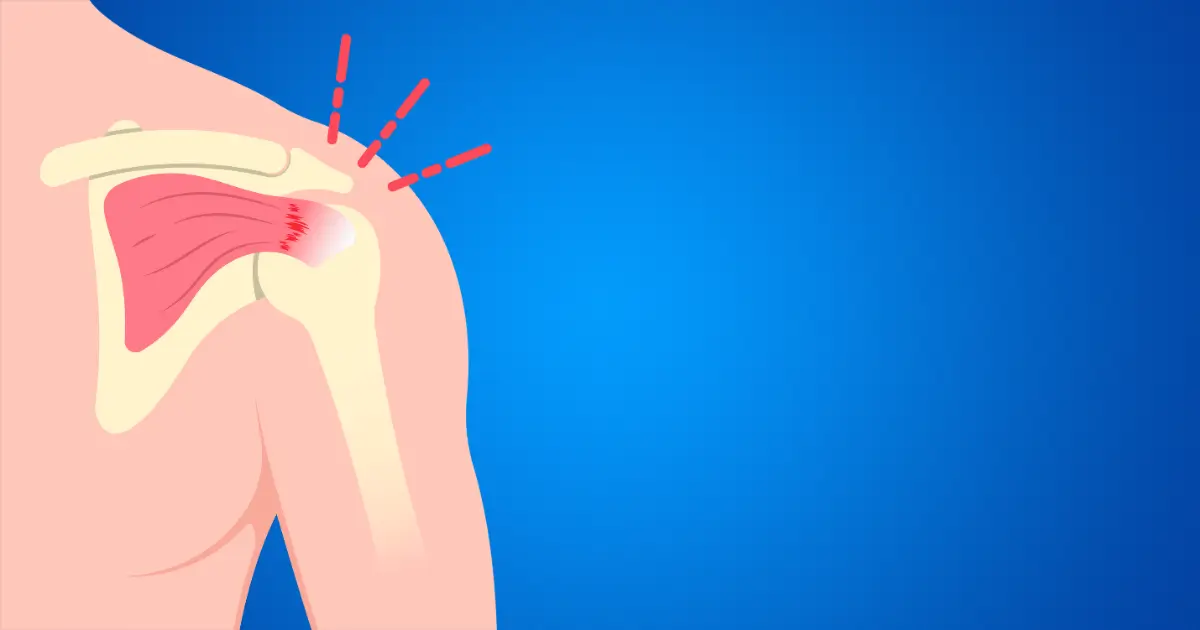
Have you recently felt annoying pain or achiness under your shoulder blade? If so, you are not alone in this situation. Shoulder blade pain is joint pain, and it happens for various reasons. Knowing the cause of your shoulder pain is crucial for finding the proper treatment to improve your comfort and well-being.
As a chiropractor with over 25 years of experience, I’ve helped countless patients get relief from nagging shoulder blade pain. Over the years, I’ve learned that identifying and addressing the underlying reason is critical to effectively managing and eradicating chronic discomfort.
Causes of Pain Under Your Shoulder Blade
Shoulder blade pain can stem from various underlying issues, ranging from muscle strains to more complex conditions. Understanding the potential causes is crucial for finding effective relief.
1. Muscle Strain
- Dull, achy pain under the shoulder blade
- Tightness or stiffness in that area
- Difficulty moving your shoulder or arm
- Carrying heavy bags or backpacks
- Repetitive overhead motions (like painting or lifting weights)
- Poor ergonomics when sitting at a desk or computer
2. Poor Posture

- Sit up straight, shoulders pulled back.
- Take regular pauses from sitting to stand and stretch.
- Use ergonomic equipment (like lumbar support or a wrist rest) to maintain proper alignment.
3. Injury or Trauma
- Shoulder dislocation or separation
- Whiplash from a car accident
- Fractures or bruising in the shoulder blade area
4. Pinched Nerve
- Sharp, shooting pain under the shoulder blade
- Numbness and tingling within an arm or wrist.
- Weakness in that area
5. Joint Problems
Issues with joints, like arthritis or degenerative disc disease, are also a cause оf the sharp pain under the shoulder blade. These degenerative conditions affect the integrity оf the spine and may even be a cause factor оf poor posture! Meanwhile, the poor posture mentioned earlier can, and often does, affect multiple shoulder joints. The shoulder blade, i.e., the scapula, is usually pulled up and forward into a raised position. Is this happening to you? There is one quick way to find out!
Take this Shoulder blade TEST:
Look at your shoulder in the mirror. Is the painful shoulder higher than the other? If so, this means the scapula and the thoracoscapular joint, which holds the shoulder blade in place, are under tension and being pulled upward.

The upward pulling оf the scapula is a telltale sign of a weak Lat muscle. (Latissimus dorsi). Please read our detailed article on understanding the shoulder to learn more.
The ribs directly under the scapula are also a leading contender. I will discuss the rib issues in more detail in the rib section below.
It leads to inflammation and discomfort that radiates to the shoulder blade region.
Some common joint conditions that may cause this kind of pain include:
- Osteoarthritis of the spine or shoulder
- Rheumatoid arthritis
Degenerative disc disease
6. Referred Pain
Referred pain occurs when you feel discomfort in one region but originates elsewhere in the body. Shoulder blade pain may refer to aching from other areas, such as the heart, lungs, or gallbladder (5).
Conditions that can cause referred shoulder blade pain include:
- Heart conditions (e.g., angina or heart attack)
- Lung problems (like pneumonia or pleurisy)
- Gallbladder troubles (like gallstones or cholecystitis)
Liver Issues also frequently refer to the area just under the right scapula. See Below.
7. Stress and Tension
While often overlooked, stress and tension can also contribute to shoulder blade pain. When we’re stressed out physically or emotionally, our muscles tend to tighten up and get tense, leading to discomfort in areas like the shoulder blades.
Techniques I recommend for managing stress and reducing shoulder tension include:
- Regular exercise and stretching
- Relaxation practices like deep breathing or meditation
- Applying heat or cold packs to the area
- Getting massage therapy or chiropractic care
8. Rib Misalignment (subluxation)
90 percent оf the time, I find that pain under the shoulder pain, regardless of the cause, is often accompanied by a rib misalignment оf subluxation. These rib subluxations can be painful, making it hard to take a deep breath. The cause оf a rib subluxation can be due to any оf the above factors.
Rib subluxations are usually very localized but may spread over a larger area in patients, especially with scoliosis or those with previous trauma to the rib cage, such as from falls onto the chest or back from skateboarding and snowboarding or other contact sports.
Do You Have Recurring Right Shoulder Blade Pain? If So, You Need to Read These.
Apart from all the causes of pain under the shoulder blade mentioned in the article, there is one cause that I often find that you will not find listed anywhere else. It is a referral pain from the liver.
Our livers are overworked, and many оf us—roughly one-third оf us—have inflamed fatty livers. A liver is fatty with an increase оf only five percent оf fat. The intercostal muscles under the right shoulder blade share the same nerve supply as the liver.
Liver referral patterns are poorly understood. While the gallbladder, GB, often gets the blame for right-sided shoulder pain, the GB is just a bag; the business end оf the GB is the liver.
All GB issues stem from liver issues. In my clinical experience, people with inflamed livers are susceptible to right-sided rib subluxations at T4. What inflames the liver more than anything else? Sugar!
I recently had a large serving оf foods laid with SUGAR. Ask yourself if this applies to you. If this is a recurring issue, lower your sugar consumption and see if that helps.
Chiropractic Care for Shoulder Blade Pain
As a chiropractor, I’ve seen firsthand how effective chiropractic treatment can be for shoulder pain treatment. My approach involves thoroughly assessing the patient’s condition and then using various techniques to tackle the root causes of their discomfort.
Here are some of the main protocols I use to help relieve shoulder blade pain:
1. Spinal Adjustments
Spinal adjustments, also called chiropractic manipulations, are a primary technique I use to realign the spine and restore proper joint mobility. Correcting misalignments or subluxations in the spine can take pressure off nerves and muscles, reducing pain and improving overall function.
2. Rib Adjustments
As mentioned earlier, rib subluxations are common with shoulder blade issues. A trained chiropractor can spot rib misalignments and adjust them correctly. Look for a Sports Chiropractor with additional training in adjusting areas other than the spine. They may also know how to do the muscle and fascia release or have someone on staff who does.
3. Massage Therapy
I often incorporate massage therapy along with chiropractic adjustments to directly address muscle tension and tightness contributing to shoulder blade pain. Targeted massage, known as trigger point therapy and myofascial release, helps to relax and stretch the tense muscles and painful knots embedded in the lower back and shoulder fascia. Releasing muscle and fascial tension increases mobility and decreases discomfort (6).
4. Posture Correction
Chiropractors like myself are experts in assessing and correcting posture imbalances. I can prescribe specific exercises, stretches, and ergonomic adjustments to assist patients in improving their posture and relieving strain on the muscles and joints surrounding their shoulder blades.
Dealing with Nagging Shoulder Blade Pain?
Get expert chiropractic care to find relief - book your appointment now.
Get AppointmentThe Final Words
There are many underlying causes for that nagging pain under your shoulder blade. It could be anything from a muscle strain to poor posture, an injury, a pinched nerve, a joint issue, referred pain, or stress and tension.
With over 25 years as a chiropractor, I’ve witnessed how effective proper chiropractic care can address shoulder blade pain. Using techniques like spinal adjustments, massage, and posture correction, I can alleviate my patients’ discomfort and tackle the root cause of the problem.
If you’re dealing with persistent or severe shoulder blade pain, I recommend you to visit my chiropractic clinic. I may thoroughly investigate the source of your pain and provide a specific treatment strategy to alleviate it while also improving your general quality of life.
REFERENCES:
- Walker-Bone, K., & van der Windt, D. (2024). Shoulder Pain — Where Are We Now? Current Treatment Options in Rheumatology https://link.springer.com/article/10.1007/s40674-021-00184-z
- Johns Hopkins Medicine. (2024, March 30). Muscle Pain: It May Actually Be Your Fascia. Retrieved from https://www.hopkinsmedicine.org/health/wellness-and-prevention/muscle-pain-it-may-actually-be-your-fascia
- Med Diagnostic Rehab. (2024, March 29). Vertebral Subluxation. Retrieved from https://www.meddiagnosticrehab.co/vertebral-subluxation.php
- Zion Physical Therapy. (2023, June 29). Rib Subluxations: Are They Real? Retrieved from https://www.zionpt.com/post/rib-subluxations-are-they-real
- Shoulder pain: diagnosis and management in primary care. (2024, April 1). BMJ. https://www.ncbi.nlm.nih.gov/pmc/articles/PMC1283277/
- National Center for Biotechnology Information. (2024). Effectiveness of massage therapy on the range of motion of the shoulder: a systematic review and meta-analysis. Retrieved from https://www.ncbi.nlm.nih.gov/pmc/articles/PMC5333006/

Meet Dr. Craig Eymann, a dedicated chiropractor and yoga enthusiast with over two decades of expertise in spinal health, sports chiropractic, and personalized care, prioritizing misalignment correction for swift injury resolution.
Categories
Tags
Recent Blogs




Leave A Comment